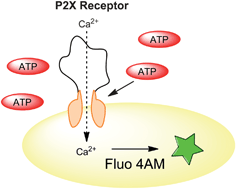Dana Spence and colleagues at Michigan State University have developed a way to study the P2X1 receptor on platelets, providing new possibilities for the research of these important cells.
The primary function of platelets in the bloodstream involves maintaining hemostasis and preventing blood loss through the clotting process.
Platelets are found in the bloodstream and function to maintain hemostasis and prevent blood loss via clotting. Adenine receptors on the surface of the platelet are important in this process, most notably the ADP-sensitive receptors P2Y1/P2Y12, and the ATP-sensitive P2X1 receptor.
Roles for P2Y-type receptors in platelet activation are well established, but the role of the P2X1 receptor is less clear as it has proven difficult to study. P2X1 is rapidly desensitised during in vitro experiments, particularly when the platelets have been separated from plasma and washed.
Here, Professor Spence – who is on the Advisory Board of Analytical Methods‘ sister journal, Analyst – and his team use the reported P2X1 inhibitor NF449 to sensitise washed platelets, enabling them to be properly studied.
In a press release from MSU, Professor Spence says, “This receptor, P2X1, has long been viewed as not important in platelets; our studies show that is not necessarily true. The receptor is very active; you just need to be careful in working with it.”
He hopes that this now opens up investigation of the P2X1 receptor as a potential drug target for the treatment of conditions such as diabetes and hypertension.
Read the paper in full:
Measuring P2X1 receptor activity in washed platelets in the absence of exogenous apyrase
Kari B. Anderson , Welivitiya Karunarathne and Dana M. Spence
Anal. Methods, 2012, 4, 101-105
DOI: 10.1039/C1AY05530E












